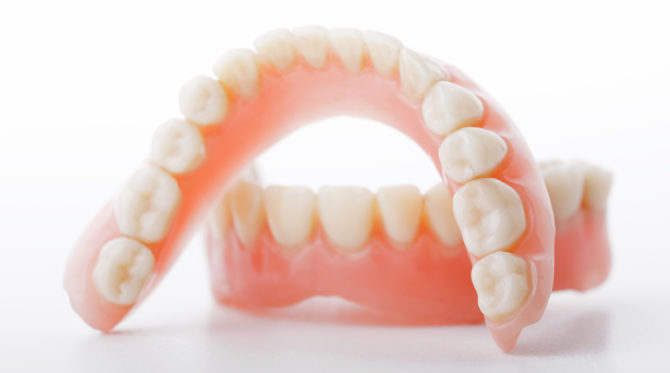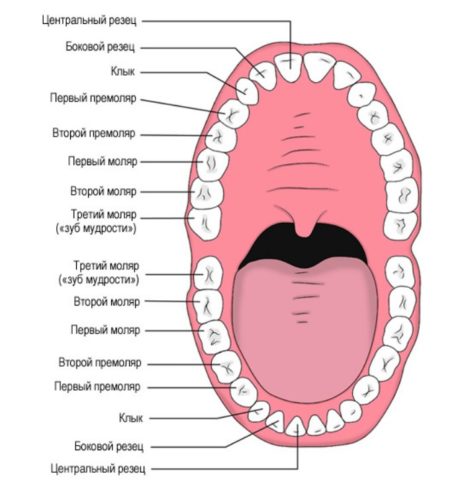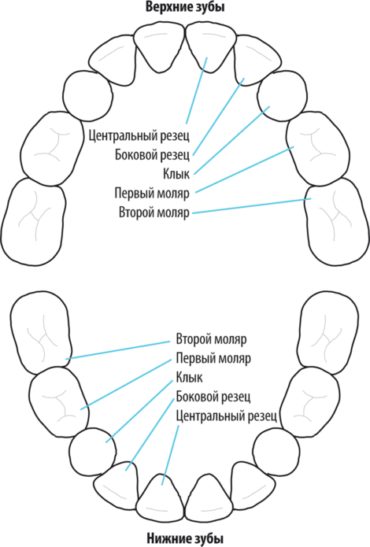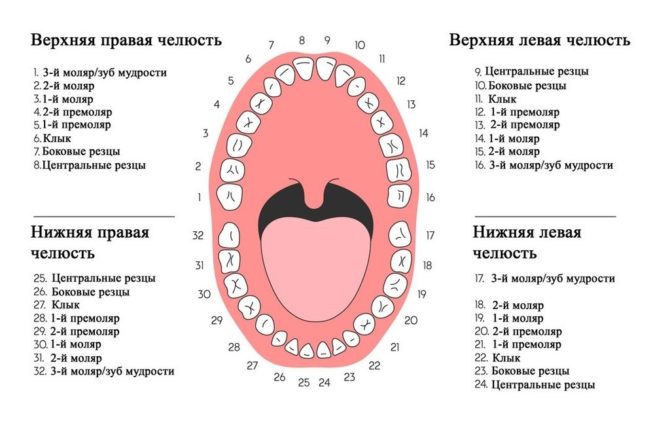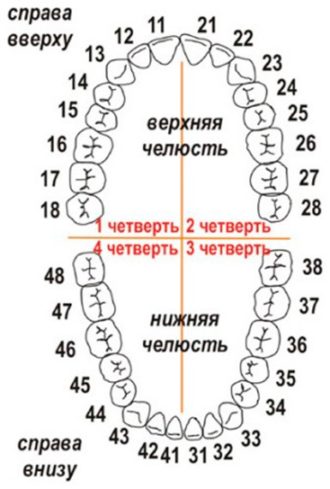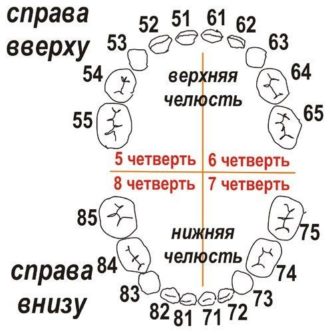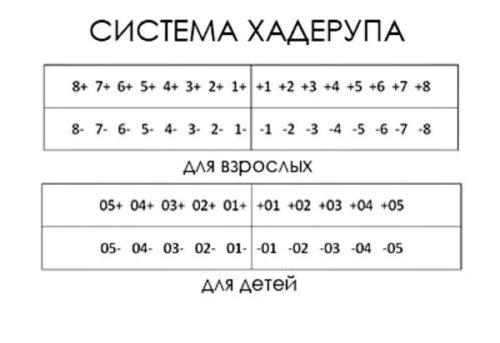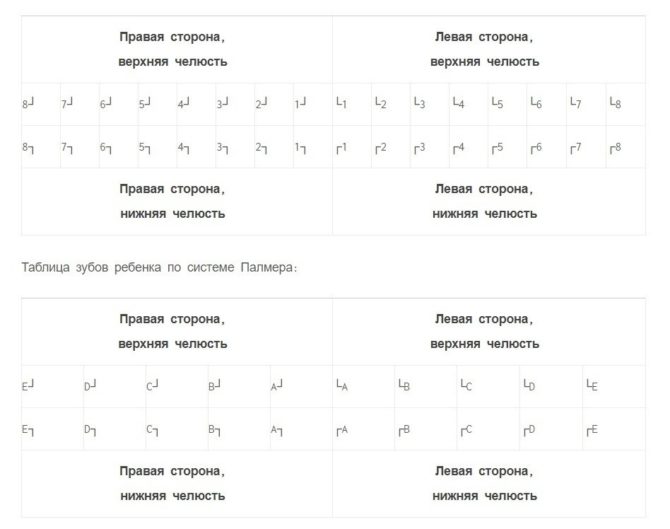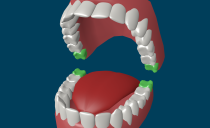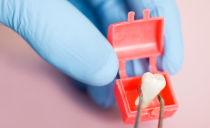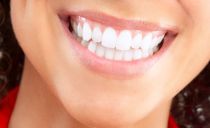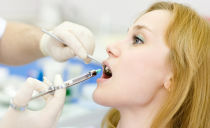Numbering of teeth in dentistry according to different schemes: from universal to Viola system
Thirty-two permanent and twenty primary teeth could well confuse the process of dental examination, if not for the numbering system developed by specialists and its numerous versions. Having put things in order, the doctors greatly simplified their work. Known teeth designation shortens the time of diagnosis, allows you to most accurately save and transmit information about the patient.
Content
Names
There are several ways in which classification is performed today. It can be a digital or alphanumeric system, but each tooth has its own name, adopted in classical dentistry, its own serial number.
Numbers and names of permanent teeth
The structure of the upper and lower jaw, the teeth and the order of their arrangement are subject to symmetry. therefore the right strategy is to start the count from the midline dividing the sky in two. In this case, the sequence of names will look like this:
- Central incisor.
- Side cutter.
- Fang
- The first premolar.
- The second premolar.
- The first molar.
- The second molar.
- The third molar (aka “wisdom tooth” or “eight”).
The names and numbering of teeth in dentistry are demonstrated by the scheme:
Looking at it, it is easy to calculate under which number this or that position is located: under the first number are the front teeth, called the central incisor, six - the first painter. And so on. Owning this system, the doctor can correctly name the “address” of the problem and correctly record it in medical documents.
Baby teeth: names and numbers
In children, the arrangement of teeth is identical to that of an adult. But the names coincide only in the first three. This is the central incisor - number 1 in the list of names, the side incisor at number 2 and the canine marked with the number 3. Under number 4 is the first molar, 5 tooth is designated as the second molar.
What is the name of the baby’s teeth, as shown in the picture:
They are numbered in the same way, counting from the conditional center of the sky. It is worth noting that children have no positions designated as premolars. They can only be found on the pattern of the teeth of an adult, since premolars appear closer to adolescence. They are absent in the milk bite.
Numbering Schemes
There are several views on how to count teeth in dentistry. Doctors of different countries and eras dealt with the problem, the result of their work was five main schemes. Some of them are more widespread and can “boast” of international recognition, others are less and well known only in the homeland of their creators, but all have a place to be.
Universal system
According to this scheme, only teeth are considered: dentitions are not divided into upper and lower. The count starts from the wisdom tooth with the right quadrant of the upper jaw, then moves to the lower clockwise. There cannot be two identical values here.
Universal tooth numbering system in the photo:
According to her:
- 6 tooth or “six” - fang of the right segment of the upper jaw;
- 11 tooth - fang of the upper left part;
- 16 tooth - the third molar of the left part of the upper jaw;
- 18 tooth - lower left molar;
- 26 tooth - lower right lateral incisor.
Determining a person’s teeth according to the numbers of the universal system is quite convenient. The way the teeth are numbered eliminates the dentist's mistakes when choosing a name, when filling out dental cards.
Viola system
This system originated in 1971. Due to the simplicity and conciseness of the names, it quickly spread throughout Europe, was adopted by the FDI and received international status. Its essence consists in dividing the jaw into segments and assigning them individual numbers:
- The right side of the upper jaw.
- The left side of the upper jaw.
- The left side of the lower jaw.
- The right side of the lower jaw.
Thus, a figure is assigned to each segment in the mouth: the lower right segment is the number 4, the upper left segment is the number 2. The teeth are also assigned a digital designation - the counting starts from the conditional midline: from the central incisor to the molars.
To indicate the “address”, a segment designation is taken, and then the tooth serial number is added to it. So, the canine on the upper jaw on the right side can be denoted by the number 13, and the second molar in the lower left row - by the number 35. 12 tooth (at number twelve) is nothing more than the upper right lateral incisor.
Photo with the scheme:
And a few more examples:
- 21 tooth - upper left central incisor;
- 24 tooth - upper left first premolar;
- 28 tooth is on the left side of the upper jaw;
- 38 tooth is located on the left side of the lower jaw. Together with the previous one, it forms molars of wisdom;
- 37 tooth - lower left second molar;
- 46 tooth - the right lower first molar;
- 47 tooth - the second molar of the right segment of the lower jaw;
- 48 tooth - the right lower third molar.
In the world of dentistry, the Viola system has established itself as one of the most convenient, understandable and logical. It does not fail, it is easy to get used to it. Therefore, Viola is used in most developed countries.
Viola for children's teeth
To avoid confusion, the jaw segments in the case of a milk bite are numbered 5–8 according to the same principle: clockwise, starting from the upper right segment. The teeth have numbers from 1 to 5. This can be seen in the picture:
In the children's version, Viola also has double-digit numbers and is equally popular among dentists.
Haderup system
It is customary to count teeth by numbers in the Haderup system. Arabic numbers from 1 to 8 participate in it, as well as plus and minus signs. The entire top row is indicated by a “+” sign. To write the bottom row use "-". If we are talking about the right side of the oral cavity, the figure is put to the right of the sign. If on the left - on the left. The child’s classification is done in exactly the same way, only “0” is always preceded by a number - in the Haderup system, this sign denotes temporary teeth.
Numbering of the dentition according to Haderup:
As you can see in the photo, the designations are easily confused. The slightest carelessness, and the doctor will not correctly determine the place where the object of interest is located. Dentists find this method uncomfortable, unreliable, not excluding errors.
Sigmondi-Palmer system
The numbering of human teeth according to this system was carried out at the end of the nineteenth century. It was invented by the Hungarian dentist Adolf Zigmondi. According to his plan, the quadrants of the oral cavity were marked with the corresponding corners, and the numbers indicated the location of the teeth by numbers. For an adult, dentists used Arabic numbers, for a child - Roman.
Later, practice revealed the imperfection of the method, the influence of the human factor on the correctness of its use. Due to the confusion of Arabic and Roman characters, there were discrepancies, errors in data transmission. In dentistry, this is unacceptable, especially when there is a removal, a complex surgical operation.
Coridon Palmer proposed a solution to the problem. He replaced Roman numerals with Latin letters. Since then, the pattern of teeth with numbers in adults and children according to Palmer looks like this:
Today, this scheme is more often used by orthodontists. Therapists have more taken root Viola and the universal system.
American system
In America, tooth numbers in dentistry are counted in alphanumeric patterns. Uppercase letters are reserved for a permanent bite, uppercase letters are for a milk bite:
- I or i are incisors;
- C (c) - fangs;
- M (m) - molars;
- P - premolars absent in babies.
The position is determined by a sequence of letters and associated numbers. But here, it’s not easy to calculate and correctly determine what the position is called. For example, according to the American system, wisdom teeth on the right and left are numbered the same way - M3. To indicate the exact location in the mouth, you must remember to add the name of the side next.
Jaw surgery does not tolerate such inaccuracies, therefore, the research of American dentistry has not received wide recognition in the world - the system is popular only in the States.
Special cases
Non-standard quantity or abnormal location is not uncommon. In this case, the teeth are counted according to the scheme accepted in the clinic: they are numbered in the order in which they should be present normally. But each additional or absent is described separately. A record is made in the map indicating where the anomaly is located.
The generally accepted order is also slightly violated when the milk bite is changed to a permanent one. Newly appeared teeth are numbered according to the “adult” system, and “overstated” milk teeth are numbered according to the child’s. So it’s easy for the doctor to find out where the replacement has already occurred, and where it is yet to be. This approach can confuse the parents of the baby, especially if two different systems are used. But for doctors this is not a problem.
It is worth noting that, if the wisdom teeth have not grown in an adult, this should not be regarded as a deviation from the norm. And, although the doctor may fill out the numbering scheme and note their absence, you should not worry about it. In recent years, scientists have come to the conclusion that in the process of evolution these “signs of wisdom" have become superfluous. They do not participate in chewing food, therefore, adult patients with missing or not fully developed eights are increasingly found.

